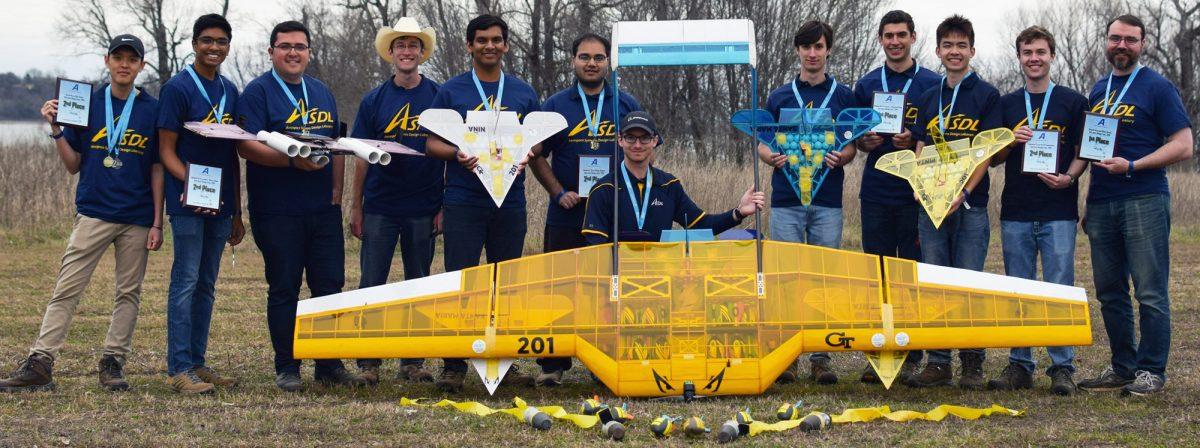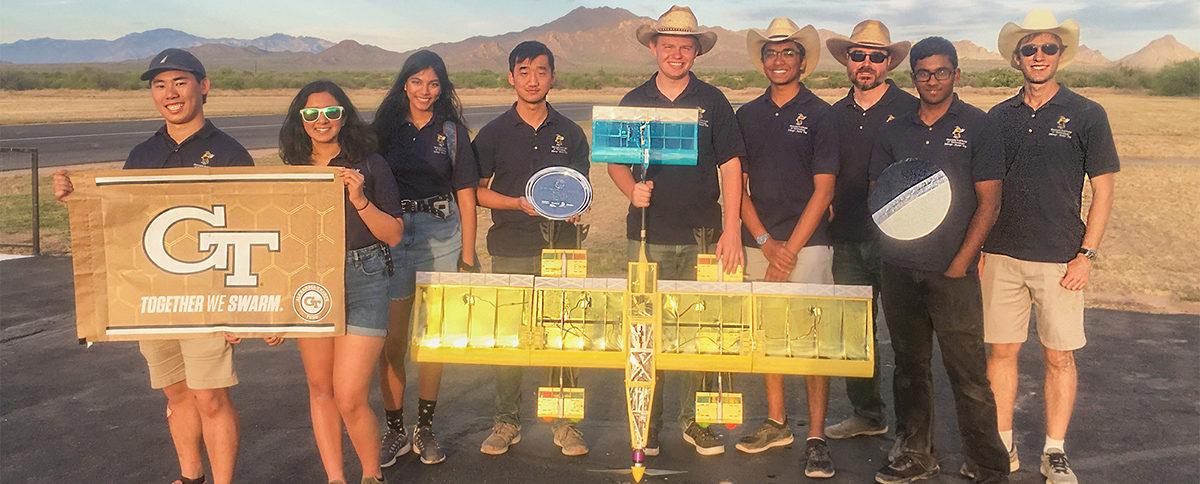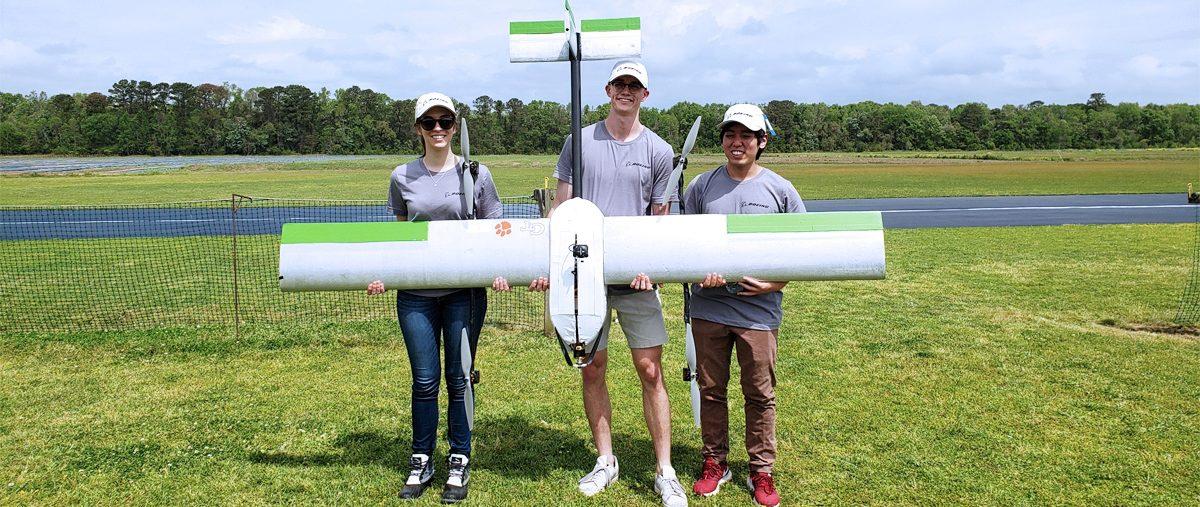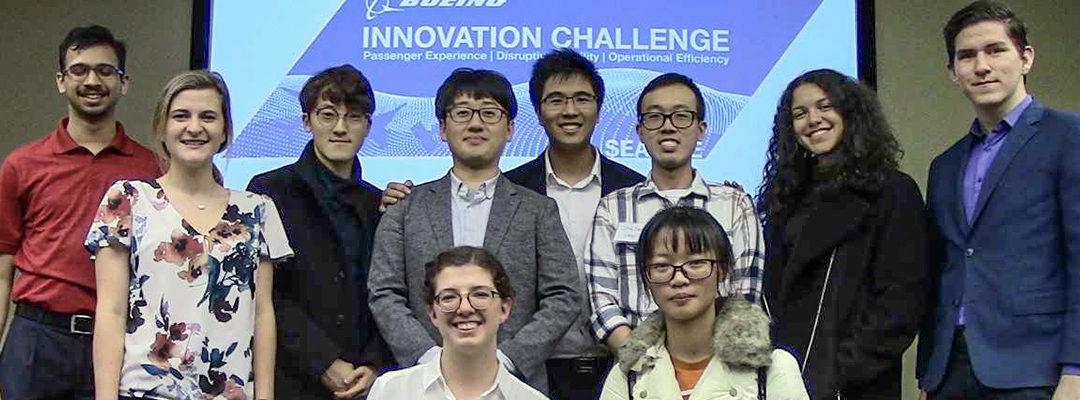Spring is always the season when AE competitors get their engines revving. This semester was no exception. From Design Build Fly to the Capstone Expo, the AE School fielded some very competitive teams. Check out the highlights:

Team ColumBuzz
ColumBuzz and Buzz-Squared Win Big at SAE Aero Design East Competition
For the fifth year in a row, two aircraft designed by students from AE's Aerospace Systems Design Lab (ASDL) landed in the top two of the Society of Automotive Engineers (SAE) Aero Design East competition, held March 8 – 10 in Fort Worth, Texas.
Placing first overall in the Advanced Class was ColumBuzz, a blended wing body aircraft that had to be capable of carrying a payload that included three autonomous gliders, each carrying ping-pong balls that represented Mars colonizers (humans). Taking a cue from history, Team ColumBuzz named its gliders after three other famous explorers: the Niña, the Pinta, and the Santa Maria.
Placing second overall in the Micro Class was Buzz^2, a UAV that had to be light-weight, quick to assemble, and capable of flying a 1000-foot loop. The official specs tasked the team with delivering the unassembled vehicle in a box measuring 12.125 inches by 3.625 inches by 13.875 inches. But one of the hardest tasks came when everyone had to work together, seamlessly.
“We assembled the plane in 20.6 seconds," said the micro class chief engineer Ogun Kargin. "We knew we had to get the time under two minutes to avoid being penalized. We practiced about 20 times to get it just right.

Taking it Home from Tucson: Posing with their award-winning aircraft, Buzzformer are (l to r) Tristan Huang, Harshini Sivakumar, Tithi Mandal, Eddie Li, Scott Nealon, Gowtham Venkatachalam, Carl Johnson, Arun Palaniappan, Matt Warren
Fielding a twelve-pound, battery-operated aircraft - Buzzformer- a team of students from AE’s Aerospace Systems Design Lab (ASDL) took home second place at AIAA's 2019 Design Build Fly Competition
Buzzformer completed three flight missions and one ground mission to best 102 other teams during the four-day competition, held in Tucson.
The specs for this year's competition tasked teams to operate within the constraints typically encountered on Naval aircraft carriers: aircraft have a limited take-off distance for their launch, they need to be optimally stored to save space, and they have to be moved from hangar to flight deck using aircraft elevators.
“It is gratifying when our student teams do well in competitions like the AIAA Design Build Fly," said Regents Professor, Dimitri Mavris, ASDL's director. "To see all their hard work pay off and get recognized from such a large field of contestants is rewarding for the students as well as all of us in AE, and we are extremely proud of them.”
read more about their win
(text and background only visible when logged in)

Calm Before the STORM: AE students Alex Miner, Andy Person, and Gen Mark Tanno pose with their award-winning drone, S.T.O.R.M. (Surveillance Technology for Organized Relief Management) in Charleston, SC. For close to 8 months, the trio worked remotely with student engineers from Clemson and Tuskegee universities (not pictured): Tyler Hayward, John Knoblauch, Connor Skelly Aaron Dorsey, Prince Johnson, Julian Thompson, and Mouhamadou Thiam.
The AE School's Team STORM, took home the Best 3D Printing, Manufacturing, and Autonomy prize in Boeing's 2019 AerosPACE Competition, held in South Carolina. Their drone, (Surveillance Technology for Organized Relief Management) also took home the best Aerospace Engineering Project at Georgia Tech's Capstone Design Expo, April 23.
Designed, built, and tested by student engineers from AE's Aerospace System Design Laboratory (ASDL), Clemson University, and Tuskegee University, STORM is a fixed-wing unmanned aerial system (UAS) that, according to competition rules, had to cost no more than $6,000 to build and be launchable by hand. Functionally, it had to be capable of helping disaster victims by carrying emergency payloads -- first-aid kits, life straw water filters, and cell phone-enabled GPS trackers -- to remote terrains.
The most challenging part of the competition might have been its location, or lack thereof: for the eight months leading up to the Charleston fly-off, engineers had to communicate, brainstorm, evaluate, and test much of their work from remote locations. Each of the 7 teams competing in the AerosPACE competition was composed of students from three different universities.
"We applaud Team STORM's design, of course, but what gives us deep pride, as engineers, is the team's ability to work remotely, with discipline and precision, for close to eight months," said ASDL director Dimitri Mavris. "The students got great real-world experience that will teach them how to collaborate across times zones and cultures.”
(text and background only visible when logged in)

Working with their peers from Cornell University and the University of Washington were many Georgia Tech grads and undergrads: Dongwook Gweon (AE), Heying Zhang (AE), Sofia Ocoro Giraldo (AE), Lorenzo Capazzo (AE), Carlota Bonnet (AE), Sandeep Kumar V. Behtapudi (CMPE), Ameya R. Behere (AE), Jung Hyaun Kim (AE), Jing Dao Chen (Robotics), and Edwin Goh (AE). not pictured: Lea Harris (AE), and Hallie Ford (AE)
Boeing's first-ever Innovation Challenge drew heavily upon the Daniel Guggenheim School for it's winning proposal: an application that would use artificial intelligence to help pilots with situational awareness and decision-making. Instead of competing, per se, the AE students who flew to Seattle this spring to participate in the challenge worked with students from Cornell University and the University of Washington for the winning entry - an integrated, automated and intelligent 'personal assistant' to help with situational awareness and real-time decision-making. The competition gave Boeing officials more than a few good ideas. It gave them leads on whom they might want to join their team - permanently.
"There is a pipeline of skilled engineers out there but there is a real competition to attract them,” Hadi noted. “We are working to engage with these students early in their academic career so we can help them see that Boeing is the place they want to build careers.”
We'd consider that a win-win.